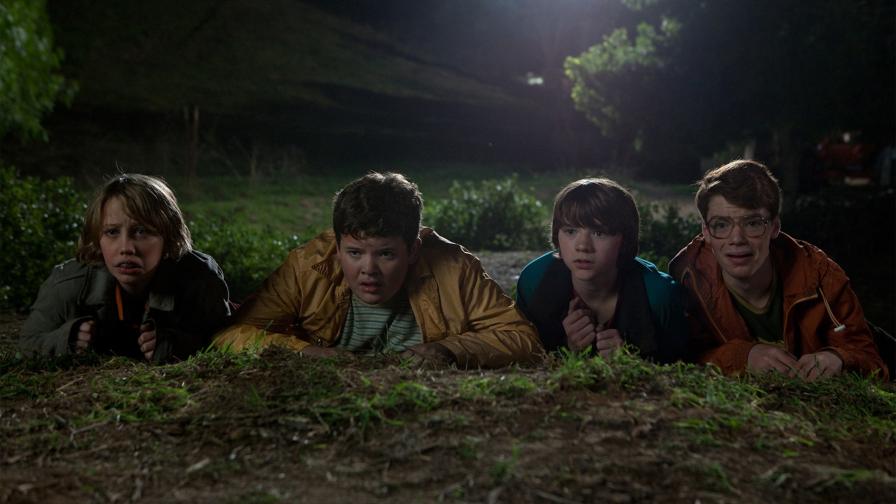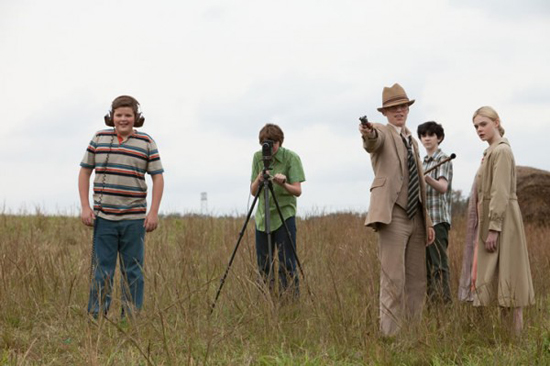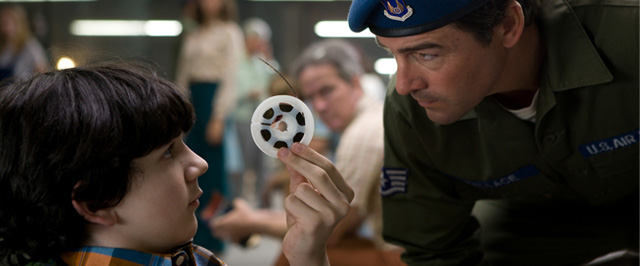Super 8
Directed by J.J.Abrams
Written by J.J. Abrams
2011, USA
J.J. Abrams’s secretive and highly anticipated third feature Super 8 arrived in cinemas earlier this week, and while it’s received fairly positive reviews, I was a bit shocked to learn how so many of my close friends absolutely hated the film. They say when you love someone, you love them even for their faults. Well I loved Super 8, and despite some strange decisions on the part of Abrams, I think it is so far the best blockbuster released this year. Of course as I mentioned on our podcast, this is a film review site, so it is only expected that we be somewhat critical. So looking at it as both a fan and critic, I’ve come up with eight reasons to love or hate Super 8.

1- Small Scale / Large Scale
The CGI-rendered train crash is one of the most visually arresting and riveting action scenes in recent memory, a spectacular set piece of superb sound design, high tech pyrotechnics and enough explosives to get Michael Bay excited. And although it is perhaps the most exciting scene within the film, it is also the most problematic. Firstly, the scene lacks believability. In one frame we see the truck that derails the train explode. Five minutes later, the six kids walk up to the vehicle only to discover the man inside is somehow still alive. Even worse, the children than quickly escape after having a gun drawn on them, simply to retire back to the suburban homes and quickly forget the entire adventure. Would children really react to such an earth shattering event in such passive ways? Even more why would the military transport such a dangerous alien being without any military supervision?
While the crash quickly grabs the full attention of the audience, the film never once comes close to matching its intensity, making the already disappointing climax seem even less interesting – thus the major problem with Super 8. Super 8 is at its best when it stays focused on the group of kids, and at its worst when it spices up a simple story with increasingly meaningless action set pieces. Everything that happens on the kid’s route is pitch perfect, and just about everything around the heavy action scenes is a little disappointing.
Everything on a smaller scale is great but once they ratchet up the effects and action, nothing seems to make sense, specifically in one scene where the small suburban town is turned into a war-zone without any explanation. Was the monster controlling the tanks and the machine guns? Why were the troops still walking around if their machine guns were firing away on their own people? And if they were firing the guns themselves, who exactly were they firing at, considering the townspeople were all evacuated and the monster was nowhere in sight? More importantly, if the monster had this power in it, why didn’t it act anytime sooner?
These are the complaints I’ve heard all week long, but there is good news: The special effects are state-of-the-art and never overused, and while I’ve been continuously disappointed with the effects in such films as Thor and X-Men: First Class, I can’t say the same for Super 8. Ever more important is that Abrams never provides explanations for any of the problems mentioned above. Often too many filmmakers provide unnecessary dialogue and exposition about the why and what, who and where, that in the end makes absolutely no sense. This is a science fiction film, but the science is omitted and audiences are left to form their own conclusions for any unanswered questions. And that is not a bad thing. Midway through the action the kids go looking for clues in a middle-school biology lab in someone else’s Super 8 film. They find the answers to everyone’s questions immediately, and while it may seem like clumsy exposition, I never felt it was ever that important in any case.

2- The Monster / FX
In classic Spielberg films, the fantastical elements serve as the catalyst to explore the family dynamic, the budding romance, the father son issues, the test of friendships and so on. Spielberg’s movies, most notably E.T. and Close Encounters of the Third Kind, had classically structured narratives whose science-fiction elements felt organically related to the rest of the story. In E.T. and Close Encounters, we the audience along with the main characters cared for the aliens, whereas Super 8‘s creature seems like a pure mcguffin, only added to advance the plot.
One lesson Abrams learned from Spielberg has its roots in Jaws: Abrams decides to shoot the monster sequences mostly off screen or in shadows for the first half of the pic. When it comes to the monster, less is more and until we get to the big reveal, the creature is rarely, if not ever seen. With Jaws, this wasn’t so much a choice as it was a necessity simply because the shark looked too fake to put on screen for too long. But the difference between Jaws and Super 8, is that in Jaws, the decision to hide Bruce is somewhat organic within the film since the shark is underwater and everyone else is above water. No one can see the shark, so it works within the context of the film. Nobody is watching Jaws thinking maybe it’s an octopus killing everyone. We know it is a shark and more importantly we know what a shark looks like. With Super 8 and all its refined special effects, it’s a deliberate decision to hide the monster. In this movie Abrams intentionally avoids showing us the monster but there was really no reason to do so – and so at one point it becomes both frustrating and distracting.
It’s a classic Abrams trope, incorporated with disappointing results in his TV show Lost. He calls it “The Mystery Box” – in other words, prolong the mystery as long as possible. Themes of childlike resistance to authority and intergalactic compassion are evident here, as they were in Spielberg’s films, but Super 8 never quite reaches it’s full potential simply because we, nor the characters in the film are ever emotionally invested in the monster itself. Abrams never seems quite sure what to make of his creature. Should we fear it or sympathize with it? With that being said, luckily for me it was never a deal breaker nor took me out of the film since I never cared about the monster to begin with.
3- 1979 and the Super 8 Camera
Writer/director J.J. Abrams teams with producer Steven Spielberg for this period sci-fi thriller set in the late ’70s, 1979 to be exact. This was a pivotal period for movie history. Only a few years earlier, Spielberg had directed the first ever summer blockbuster Jaws, and followed it up with Close Encounters and E.T. Super 8 is after all an homage by its writer/director, to its producer, the kind of high-profile movie we so rarely see these days, an old-fashioned, good-feeling summer movie spectacle that doesn’t rely on sequels, spin-offs, re-boots, adaptations, 3-D, comic tie-ins or big name movie stars. It’s also a love letter to all those with a passion for filmmaking that emerges at a young age and an offers today’s generation of movie-goers a hint of what it was like for their parents to go to a theatre during the ’70s and ’80s.
Setting the action in 1979 allows for a dose of well-earned nostalgia with the Super 8 camera in the spotlight, an artifact of the past and without it, the world may have never known Spielberg nor Abrams, since both men got their start with the now forgotten format.
4- Art Imitating Art
The reoccurring argument or question I constantly hear is if Super 8 suffers from the post modern condition, of art imitating art. Filmmakers (at least in Hollywood) are not making personal films anymore – instead making films replicating those of the filmmakers they grew up watching. Perhaps the filmmaker who does it best is Tarantino – his movies steeped in pop culture and the world of the directors that influenced him. But with Tarantino you feel his passion and love in every frame. The question is, does Super 8 supply more than pastiche?
The plot is a mishmash of various sci-fi and Spielberg tropes, but Abrams, who wrote the script, has enough storytelling savvy to keep you invested from start to finish. Richard Roeper called it a cinematic version of a cover band. He overloads this sci-fi adventure with so many homages to his co-producer Spielberg’s work that it plays like the older director’s greatest hits.
There is truth in that statement, but there is more on screen than Spielberg himself. We see the influences from Poltergeist, Goonies, Iron Giant, The Thing, Phantasm, and George A. Romero’s Night of The Living Dead with passing winks at The Explorers, WarGames, Duel and even Gremlins. Toss in a healthy measure of War of the Worlds, Jurassic Park and a nod both to Abrams’ TV mystery Lost to the classic Twilight Zone episode Walking Distance and you have enough references weighed both for maximum nostalgia and hipster cred.
But back to the question two paragraphs above. There are parts that feel very authentic coming straight from the heart of Abrams, and we see this most in the scenes featuring the kids making the film within the film. There’s a thin line, however, between paying respect to what came before and copying it, and Super 8 occasionally crosses over that line. Thus the problem with Abrams. He has distinguished himself as an exceptional craftsman but still lacks a distinctive director’s signature. So even his most personal work is covered in the fingerprints of another filmmaker’s style. But Super 8 is saved because he at least understands the rules of the game: Keep a sense of humanity in the film. Spielberg’s films all balance epic narratives with an element of humanity. Abrams effectively conveys a mix of innocence, fear, wonder and childhood adventure that Spielberg managed to create again and again both in film he himself helmed or in classics he produced such as Stand By Me and The Goonies.
I guess you just have to ask yourself – does it have heart, or is it simply pastiche?

5- Methaphor
The movie does have a moral, mostly about the length to which we’re driven by our fear of the unknown and lessons about letting go. Abrams said the creature in is intended to work as a metaphor for something deeper, a way to externalize and make physical this thing that this kid was going through internally. Unfortunately, I am not sure that metaphor is really communicated, but I do believe that Joe’s journey was captivating enough to overlook this flaw.
6- Production Values
Super 8 is Spielbergian not just in story but in technique, as well with great production values including the beautiful widescreen picture by cinematographer Larry Fong (Watchmen and Sucker Punch) and a great score by composer Michael Giacchino, who does a very good impression of John Williams. Several of the director’s preferred camera angles and movements are on display and like his mentor, he keeps the pacing quick and agile without being frenzied. Super 8 never slows down, for better or worse, and Abrams shows-off incredible attention to period detail, with the automobile, rotary dial telephones, U.S. steel factories, walkie-talkies, and late ’70s pop tunes. Oh, and those intentional, infernal blue light flares he uses comes à la Close Encounters of the Third Kind. Be it an empty style exercise or a director’s trademark, it actually makes sense in the context of a Spielberg homage.

7- Casting
Unlike many science fiction features, this one puts the characters before the monsters and the action. Abrams remembers the simple rule: action only has meaning when an audience cares about the people they are watching. It helps the cast is so incredible. The unforced performances of Courtney and Fanning are remarkable, and because their characters are so fleshed out and deeply felt, the movie’s mystery takes a backseat. The mildly profane overlapping banter among the smart, likeable, nerdy 12-year-olds seems so natural that you wonder how much was improvised, if any. Joe and Charles’ scenes together are better-written and acted than most adult friendships in Hollywood films. Unlike the kids in the Goonies, these kids are more dynamic – and different not all constantly shrieking – and all have different styles. Their dynamic and history with each other are established in the swiftest of strokes. Perhaps because the children are doing precisely what Spielberg and Abrams did when they were of that age – shooting a student film via an 8-mm. camera. Joel Courtney shows more poise than the average Joe in his professional debut; while for the second time in a year, Fanning proves to be one of the brightest young stars working today, emerging from her older sister’s shadow.

8- The End and The Beginning
The prologue seems to be an issue for many people but I think it is a really effective scene, communicating up a lot of information while quickly establishing the emotional stakes at large. The ending seems to be a deal breaker for others. Spielberg is great at endings and you would think he would have advised better.
The climax, for all its special effects, felt like a second hand garage sale purchase from Spielberg’s most manipulative moments. Regardless if it gets dusty-eyed in the cinema for you or not, we are saved with an additional ending, The Case, the no-budget zombie film within the film that plays out in its entirety over the closing credits – a short that is so entertaining you’d wished the multi-million-dollar spectacle matched its charm.
All in all, Super 8 is not a perfect film but neither it, nor Abrams deserves the rather harsh remakes they have received. It’s an enjoyable, riveting, well-acted sci-fi adventure and coming-of-age drama, pitting a group of middle-school kids against the world.
– Ricky






